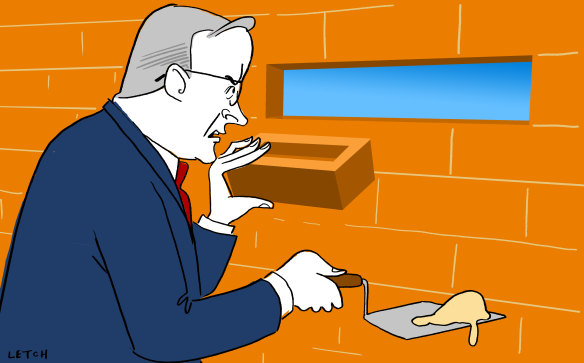This was published 1 year ago
Opinion
Why fixing negative gearing would be a positive for our kids
Ross Gittins
Economics EditorLife wasn’t meant to be easy for our politicians – which is as it should be. Poor old Anthony Albanese. No sooner has he got away with breaking his promise on the stage 3 tax cuts than he’s besieged by people demanding more tax reform.
Trouble is, they all want different things, and every one of them could cost him votes as fat cats who stand to lose some tax break join forces with the opposition to run a great scare campaign, claiming it’s ordinary voters who’d be hit.

Illustration by Simon Letch.Credit:
Despite the many things wrong with our tax system, the two big parties have wedged themselves into a corner on reform. Neither side’s game to do anything for fear of what the other side would say.
But when, unsurprisingly, polling showed that most people approved of Albanese’s decision to switch about $7 billion a year of the tax cuts away from those at the top and give them to those in the middle and bottom, the would-be reformers swarmed out of the woodwork.
First out was the (big) Business Council, terribly worried about the lack of investment and the need for greater productivity. I’ll check their claims another day.
Then came two of our best economists, professors Ross Garnaut and Rod Sims, proposing to bring back the carbon tax, only bigger and better. As I wrote last week, it’s a good idea.
But the one to watch, another old favourite, is the talk of finally doing something to curb the negative gearing of investment properties, which really took off 20 years ago after John Howard decided that the capital gain on property and other investments should be taxed at only half the rate applying to income from actual work.
A rental property is negatively geared when so much of the cost of buying it is covered by a loan rather than your own savings that the interest bill and other expenses exceed the rent you earn.
Why would anyone deliberately set up a business to run at a loss? Because the loss is deductible against your income from work. On a small investment of your own money, you sell the property a few years later at a big capital gain, only half of which is taxed. Not bad, eh?
Former Treasury secretary Dr Ken Henry reminds us that the rental property sector’s deductions are now so huge they exceed the rental income, making it not a net taxpayer. Taken together, all those landlords contribute nothing but are being subsidised by the mug workers.
What should worry Albanese is that the Greens are now pushing negative-gearing reform as part of their efforts to rebrand themselves as the party that cares about renters and first-home buyers.
If Labor doesn’t start showing it wants to improve the daunting prospects facing the younger generation, it risks losing its share of the youth vote to the Greens. The Libs needn’t worry, they’ve lost most of their share already.
Some years ago, the Grattan Institute proposed allowing landlords’ rental losses to be deducted only from other “passive” income, not wage income. There must be some recognition that capital gains shouldn’t be taxed at their full, inflated amount, so the 50 per cent discount should be cut to 25 per cent.
Another approach would be to allow losses to be deducted against wage income only if the investment property was newly built. This would overcome the objection that investors usually buy established homes, thus adding to the demand for homes without adding to their supply, and so pushing prices up out of reach of first home buyers.

Former Treasury boss Ken Henry has pointed out the shortcomings of negative gearing.Credit: Rhett Wyman
Now, the business people who see themselves as losing from the restriction of negative gearing – the real estate agents and home building companies – always claim it would do great damage to renters and home buyers alike. Don’t believe it. When economists try to estimate the likely effects, they find them to be small. Average house prices would fall by just 1 or 2 per cent, they say. So much for the death and destruction.
But these sums underestimate the likely benefit to young buyers. While the fall in the average price of all houses and units may be small, that’s because most house prices would be unaffected. Entry-level homes, the kind bought by mum-and-dad investors and first-home buyers, would become more affordable because those prices would fall by a lot more.
What’s more, a recent study finds that the share of households who own their home rather than renting it would increase by a huge 4.7 percentage points. Nor would it surprise me if, in practice, the effect was greater than the economists’ figuring suggests.
Even so, fixing negative gearing is no magic answer to housing affordability, and the Albanese government’s efforts to increase the supply of housing, particularly in the parts of cities where people prefer to live, is another part of the answer.
Albanese and Treasurer Jim Chalmers say they have no plans to change negative gearing, but that’s what they said about changing the stage 3 tax cuts – until they were ready to move.
And with the Greens using negative gearing as a bargaining chip in the Senate, progress is far from impossible.
Ross Gittins is the economics editor.
Ross Gittins unpacks the economy in an exclusive subscriber-only newsletter. Sign up to receive it every Tuesday evening.